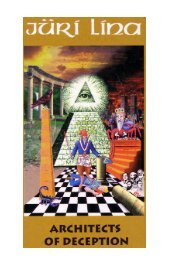September 11 Commission Report - Gnostic Liberation Front
September 11 Commission Report - Gnostic Liberation Front
September 11 Commission Report - Gnostic Liberation Front
Create successful ePaper yourself
Turn your PDF publications into a flip-book with our unique Google optimized e-Paper software.
“Lt. Vreeland gave clues that his main contact/control was Jack Punches. From the memorial pages:<br />
U.S. Navy Capt. (Ret.) Jack Punches worked in the Pentagon as deputy head, Navy Interagency<br />
Support Branch. Punches was killed in the attack of Flight ”<br />
“I was sent (to Moscow) by the U.S. government and the ONI [Office of Naval Intelligence]. I got my<br />
orders between Sept. 4 and Sept. 7, 2000. Marc Bastien departed for Russia on Sept. 7, 2000. I had<br />
orders to meet him. Bastien was going to work at the Canadian embassy regarding diagrams and<br />
blueprints of a weapons defense system. The U.S. government had a direct influence on his mission.<br />
The name of the defense system is SSST [Stealth Satellite System Terminator]. There are five different<br />
individual and unique defensive and strike capabilities of the system. The only portion that I have<br />
publicly spoken on is one frame regarding actual current orbiting satellites, which are not at this time<br />
owned by the US government. On advice of counsel I cannot discuss the other components.<br />
This one component is a satellite system. Within the confines of the system there are multiple,<br />
deployable space/orbital EMP [Electromagnetic Pulse] missiles that are not aimed at the ground. They<br />
are targeted at everyone else's satellites. These would kill worldwide communications. The satellites of<br />
some countries that are shielded with titanium are protected from these weapons. The protected<br />
countries are Russia and China, but U.S. satellites are vulnerable and Putin has told Bush that the U.S.<br />
missile defense system doesn't work, and that Bush knows it.<br />
The reason why I went to Russia was because I needed to meet with Bastien and another individual<br />
from the Russian Ministry of Defense named Oleg. The purpose was to get the Canadian diplomat who<br />
had made contact with Oleg to get the book of designs out of the ministry's R&D. That was done. We<br />
copied the entire book. Then we took certain documents, and we changed serious portions of the<br />
defense design so the program wouldn't work. They know this now.” [FTW Interview: Delmart "Mike"<br />
Vreeland, What the CIA Doesn't Want You to Know, Michael C. Ruppert, FromTheWilderness.com]<br />
What is generally ignored by most writers is that Vreeland claimed to have documents<br />
(over 100 pages of bank transactions with 6 transactions per page, with one on Aug <strong>11</strong>,<br />
1989 for $100 Billion.) exposing a massive, fraudulent theft of billions of dollars from<br />
the U.S. Treasury. He shared these documents with Michael C. Ruppert, who discusses<br />
them in his report Crossing the Rubicon. What is important to note is that these<br />
transactions start as early as 1989, and the ONI documents were also released to Ruppert<br />
and others by another Navy Intelligence agent. These documents suggest that the ONI<br />
was probably investigating a large money-laundering scheme, as rumored in some of the<br />
press. In reviewing these documents, it becomes clear that for the 18 months covered by<br />
these documents, Robert Hermann (later to become Vice President and the principle tax<br />
strategy architect for Enron, although the ONI documents may be referring to Robert<br />
Hermann of the National Security Agency, who worked extensively in the White House.)<br />
was working with international banking cartels to refinance third world debt in the urgent<br />
need to prevent the collapse of the US banking system. (Michael Bowe and James Dean<br />
provide an excellent overview of this period in their report: “Has the Market Solved the<br />
Sovereign-Debt Crisis?” Princeton Studies in International Finance, No. 83, August<br />
1997.) Working with a strategy labeled “concerted market-based debt relief” Hermann,<br />
Brady, Bush and Greenspan were apparently creating securities ironically named “Exit<br />
Bonds.”<br />
“Exit bonds are new bonds issued at discount in exchange for old debt. Exit bonds, like buybacks, were<br />
rare before Brady, because of similar coordination challenges reinforced by legal clauses in syndicated<br />
loan agreements. Because exit bonds are generally either collaterized or made senior to the reminaing<br />
old debt, they can be exchanged for old debt at a fraction of its value. If the bonds are fully<br />
collateralized, for example, they are as good as cash…” [Michael Bowe and James W Dean, Has the<br />
Market Solved the Sovereign-Debt Crisis?, Princeton Studies in International Finance, No. 83, August<br />
1997]<br />
THE SEPTEMBER <strong>11</strong> COMMISSION REPORT Page 201







